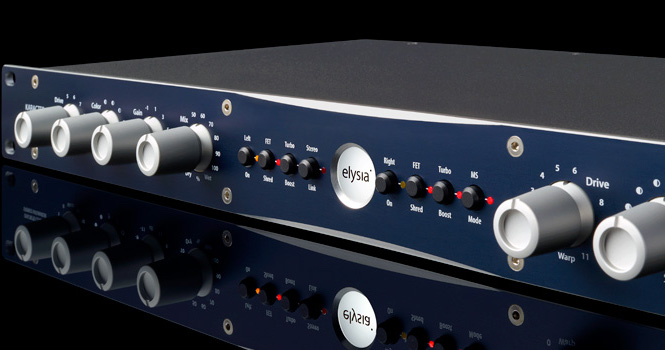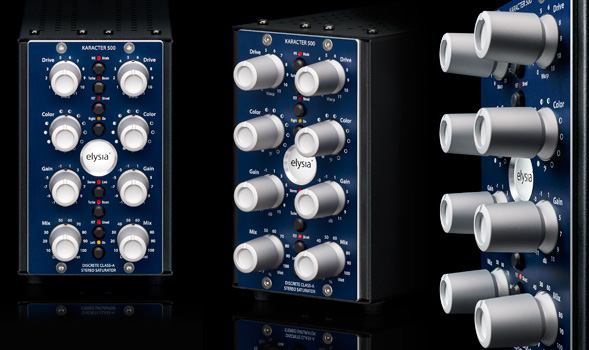New Gear Review: karacter rack “Coloring Box” from elysia

A view of the new rack version of the karacter “coloring box” from elysia. Unlike the original 500-series module, the 19″ rack format includes CV control capabilities so that you can “play” your distortion.
Anyone who has worked with me knows I am a nut about distortion. I love it. There are many different options out there when it comes to adding a bit of fuzz, grit, dirt, shred, warmth, fizz, buzz, aggression, gain, drive, color, saturation or whatever it is you are looking for when it comes to making sounds less pristine. For me, having a variety of types and styles of distortion at hand is pretty key to any recording or mix these days.
elysia has introduced a new distortion box, The karacter, originally in a 500 series version, and now, in 19″ rack version. It has, as they proudly proclaim it, “Discrete Class A Topology”. Personally I don’t mind if it’s class A or Z—sometimes the worse, the better if you know what I mean—but I’m sure that will be important for some people.
Features and Use
The controls on the front of the box are Drive, Color, Gain, Mix, Bypass, M/S mode, Turbo Boost and FET Shred.
“Drive” allows you add more….well…Drive to whatever you happen to be sending through it.
“Color” is a filter that impacts the way the source is being distorted, giving you either a more fat and thick distortion, or a crispier-fried distortion. This knob had the most pleasing effect to me, and really allowed me to shape the sound. Without it, I think the karacter would be no where near as interesting as it is.
“Gain” allows you to bring down the output once you have found your desired level of saturation.
You can have fun with these three knobs alone and spend days or weeks dialing in various monstrous sounds, but the fun does not stop there: The “Mix” control again, is very self explanatory, and allows you to adjust the blend, just in case you don’t want to completely decimate your source, but rather add a layer of decimation parallel to your clean signal.
That covers the four dials for the left side and right side, all of which are finely stepped—something which I love especially if things need to be recalled. I say “finely”, as they are not large steps, so you never feel like you are missing out like you might when clicking knobs with large detents
There is a “Turbo Boost” button which, well again, is fairly self explanatory. It jacks up the amount of distortion. I didn’t find this particularly useful, but I believe that is because I was feeding very healthy signals into the unit to begin with, so there was more than enough distortion taking place already. I think though if you had a quieter source, this might end up being more useful.
Then, there is the “FET Shred” mode. This changes the distortion style from symmetrical to asymmetrical. According to the manual, which I only read after I had played around with it, this mode “reminds of the style a driven tube amp would sound like.” I’m not sure if I totally agree. I found the difference to be, not subtle, but I guess just a different shape as opposed to a totally different style of distortion. Depending on the source, I found that one mode seemed to suit better than the other, but without any real predictability. I wasn’t like drums always sounded better in FET Shred, or horns in the regular mode. It was always unpredictable. (Oxymoron?)
The karacter also has a stereo left/right link, which is great, but the real winning feature of this box is the M/S mode. I have not seen this on a hardware distortion box before, and I think it is a huge plus. I messed around a lot with running stereo drums through the karacter in M/S mode and using it to change the stereo image of the drums and creating “sampled/looped” sounding drums that fit the song. I bet this would be awesome for sampling off of old records…if anyone still does that.
The only difference between the 19″ rack version and the 500 series version of the karacter is that the rack version has CV controls over the drive and mix parameters. This means that you could hook up an analog synth and use it to change the values of those two functions. This gives one the ability to “play” the distortion. I imagine If one had a Kenton MIDI-to-CV converter, it would allow you to control those two functions from your DAW, leaving even more possibilities for triggering off of other instruments and MIDI parts. There are endless possibilities here. I think for this reason alone I would opt for the rack over the 500 series.
Summing it Up
I would say that the elysia karacter is a great addition to a studio, whether home or professional. It adds a new texture to the arsenal, new abilities in the way I can distort things, and new ways to apply distortion. For my tastes, the karacter might be best used in a tracking situation. I enjoy tracking with a distortion and will often print to “tape” like that. The most common box for line level distortion that I have encountered is the Themionics Culture Vulture. I would take the karacter over this any day. It is simply way more versatile and has the ability to be more finely adjusted, which makes it a more useful distortion. And to top if off, there is the ability to play it with CV control—a very innovative idea.
Please note: When you buy products through links on this page, we may earn an affiliate commission.







